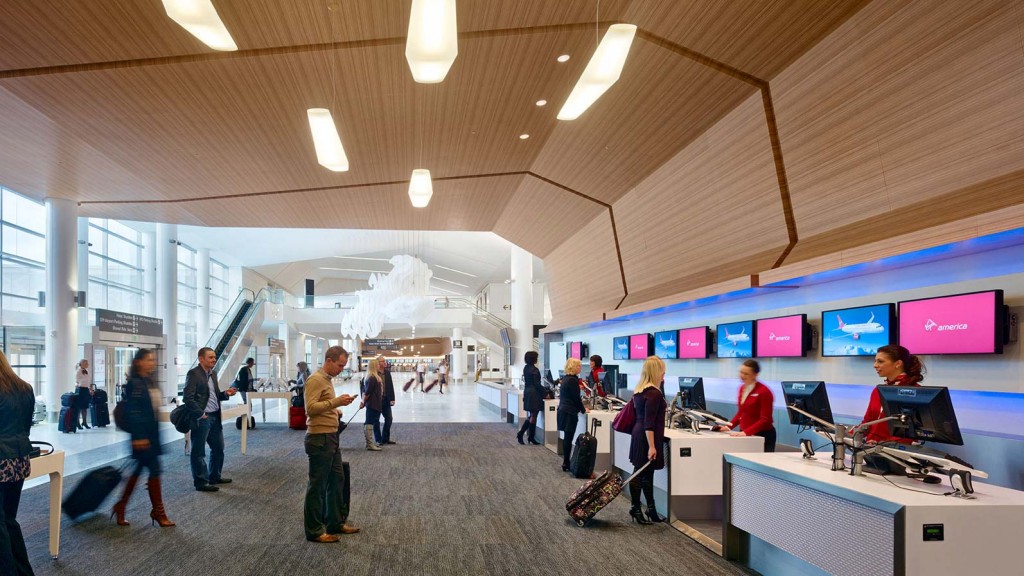Which airport spaces drive positive travel experiences?
Aviation Performance Index
What We Did
We created a comprehensive survey tool to measure airport terminal performance and passenger satisfaction in connection with terminal design. This includes two parallel surveys designed to capture the experiences of both terminal employees and passengers. One set of questions focuses on the passenger experience: How do the effectiveness and attributes of a suite of physical spaces influence passenger experience and customer loyalty? A second set of questions focuses on operational efficiency: How well does the design of a terminal enable employees to perform their job functions effectively and efficiently? What is the impact on employee satisfaction and commitment? Our tool is designed for both predesign and post-occupancy evaluation.
The survey is organized into nine sections focusing on everything from baggage claim to concessions. Initial testing focused on two areas where we see the most opportunity: the check-in and hold-room experiences. We tested the survey at an international terminal at New York’s JFK airport. Over five nights, a team of two people administered the survey using iPads to gather insights from departing passengers waiting in holdrooms. We received 215 responses. We hope to use this data to identify and prioritize critical success factors in the design of the terminal to drive passenger experience and employee performance. Our goal is to collect data to improve the design of airports and terminals and provide evidence-based benchmarks to support client decision-making.
The Context
There are numerous evaluations for passenger experience and airport effectiveness; yet few, if any, address the role that design plays on these metrics. Air travel is becoming more expensive and security-heavy, making the imperative to deliver a more positive terminal experience all the more important as airlines compete with each other and other modes of transportation— from passenger rail to buses and cars. Shifting airport business models are also driving higher expectations for retail and restaurant revenue from terminals—a factor that can depend on a positive experience.
The Results
Preliminary findings suggest a relationship between terminal design and passenger satisfaction. Factors that contribute to way-finding and efficiency appear to be the most influential. Passengers noted the importance of the quality of the physical environment at the airport terminal (for example, comfort, light, way-finding) to their travel experience, with an average ranking of 7.4 on a scale of 1 to 10. The spatial factors ranked most important to the travel experience were the restrooms, security checkpoint, baggage claim, customs, and ability to get to and leave the terminal.
Overall, passengers were satisfied with the check-in hall in this test survey, giving an average ranking of 7.2 on a scale of 1 to 10. The factors that contributed most to passenger satisfaction at the check-in hall were the number of check-in points and understanding where to check in. Gate/hold room satisfaction ranked lower, at 6.6 on a scale of 1 to 10. The factors that contributed most to passenger satisfaction in gate/hold-rooms were comfort of seating and the ability to locate the gate easily.
What This Means
Intuitive way-finding is essential. The ability to easily get in and out of the terminal, understand where to check in, and locate the gate is a key factor in a positive travel experience.
Make checking in easy. The efficiency and quality of the check-in experience are also primary drivers of satisfaction.
Pay attention to restrooms. The quality of terminal restrooms has an outsize impact on perceived terminal quality and is an opportunity to elevate the passenger experience.
Airports should be comfortable. In the terminal we studied, the gate/hold rooms showed opportunities for improvement through interventions that would make the passenger experience more pleasant and comfortable.
What’s Next?
Due to the limited data collected, we are not yet able to link overall airline passenger satisfaction scores to terminal design factors, nor are we yet able to assign scores to a terminal. We continue to use the framework as a supplementary programming tool for airport terminal projects.
Learn More
Team
Bill Hooper, Keith Thompson, Darris James, Cliff Bollmann, Kashyap Bhimjiani, Marion White, Andreas Andreou, Isabel Kraut
Year Completed
2011
Comments or ideas for further questions we should investigate?
